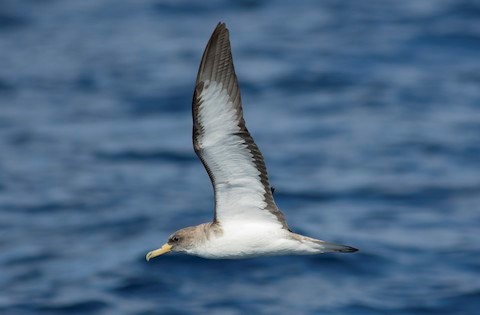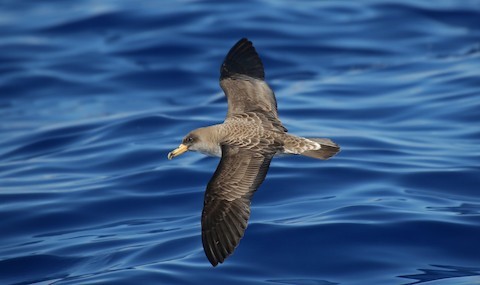Birdfinding.info ⇒ Common throughout Macaronesia—the Azores, Madeira, and Canary Islands—from February to November. Also common in Atlantic waters of the Iberian Peninsula during that season. In North American waters, it is common and readily found on pelagic trips from May to November all along the Atlantic Seaboard from Nova Scotia to Florida waters and in the Gulf of Mexico west to Texas, but peculiarly scarce in Mexican waters and the West Indies. In the Southern Hemisphere, seen most often in Benguela Current waters of Namibia and South Africa from December to February, and also regular in the warmer Agulhas Current east to the Mozambique Channel.
Cory’s Shearwater
Calonectris borealis
Breeds in Macaronesia and disperses throughout the temperate and tropical Atlantic.
Breeding. Nests colonially in crevices on cliffs and rocky islets. Arrives at colonies around late March or early April, and departs around late October.

Approximate locations of Cory’s Shearwater breeding colonies. © The Sound Approach 2019
The vast majority of the global population (~85%) nests in Portuguese Macaronesia: throughout the Azores and Madeira (including the Selvagens). The largest colony is on Selvagem Grande (~30,000 pairs).
Most of the remaining ~15% nest in the Canary Islands, mainly in the northeasternmost islets—an estimated 11,000 pairs on the Chinijo Archipelago (north of eastern Lanzarote).
There are isolated, much smaller colonies near the coast of Portugal on the Berlengas Islands, and a few pairs have been found breeding at various sites in the western Mediterranean, mostly in Scopoli’s Shearwater colonies (but rarely in mixed pairs): on the Terreros Islands of Almeria, Spain (~10 pairs); the Chafarinas Islands, beside northeastern Morocco (~20 pairs); and a few pairs each at Hyères, France, and Giraglia, Corsica.
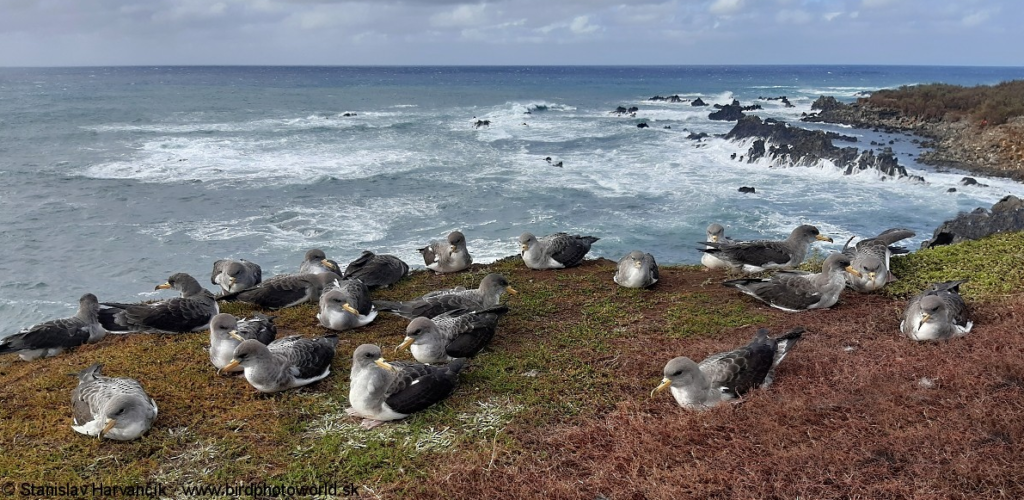
Juvenile Cory’s Shearwaters preparing to leave their natal colony. (Corvo, Azores; October 26, 2019.) © Stanislav Harvančík
A few individuals have been discovered at several other Scopoli’s Shearwater colonies elsewhere in the western Mediterranean east to Linosa (south of Sicily).
Nonbreeding. From November to February, most of the global population winters in the South Atlantic in temperate waters from southern Brazil to central Argentina and around southern Africa from Namibia south and east at least to the Mozambique Channel, and to some extent farther east into the Indian Ocean. Mid-year records indicate that some nonbreeders remain in the South Atlantic year-round.
Many nonbreeding Cory’s Shearwaters spend the breeding season (May to November) in the western Atlantic, mostly in U.S. waters from Florida to Nova Scotia, and in the Gulf of Mexico. During the summer, their numbers grow and some move north to Newfoundland waters.
Vagrants are regularly found outside the normal range in the Indian Ocean, as evidently disoriented flocks sometimes migrate north along the east coast of Africa, and ultimately reach a dead-end at Eilat, Israel, or in the Gulf of Oman.
More exceptional vagrants have been found in waters of southwestern India, southwestern Australia, and in the Pacific Ocean in waters of California and Baja California.
Identification
A large shearwater (the largest of all) with gray-and-brown upperparts and white underparts, and a large pale-yellow, dark-tipped bill.
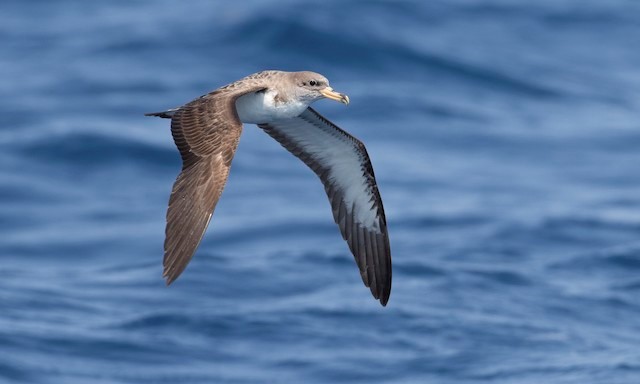
Cory’s Shearwater. (Offshore from Cape Hatteras, North Carolina; June 7, 2018.) © Brian Sullivan
Nearly identical to the slightly smaller Scopoli’s Shearwater (formerly considered conspecific; see below for more details), with the only consistent visible difference in the undersides of the primaries: nearly all-dark on Cory’s versus variable white “tongues” on the inner webs of Scopoli’s which extends about halfway from the primary coverts to the wingtips. (For a more diagnostic distinction, see Voice section below.)
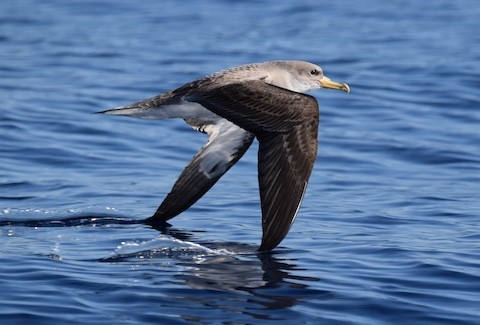
Cory’s Shearwater, shearing the water. (Offshore south of Madeira; October 30, 2019.) © A. Emmerson
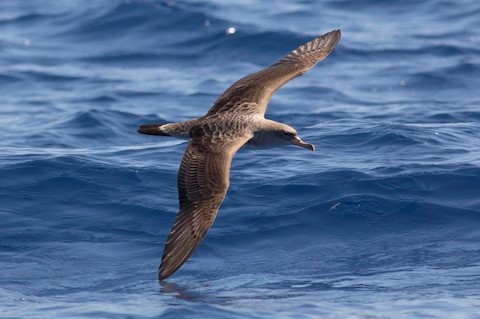
Cory’s Shearwater. (Offshore from Hatteras, North Carolina; May 26, 2018.) © Michael Todd

Cory’s Shearwater. (Offshore north of Madeira; August 4, 2016.) © Eric François Roualet
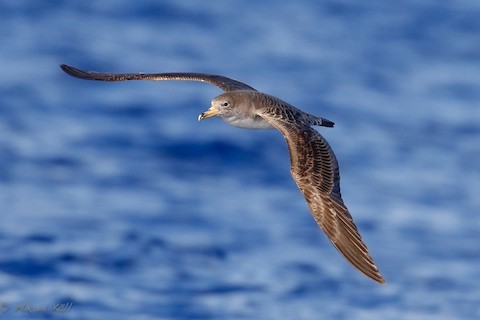
Cory’s Shearwater. (Offshore north of Madeira; July 24, 2021.) © Mikael Käll
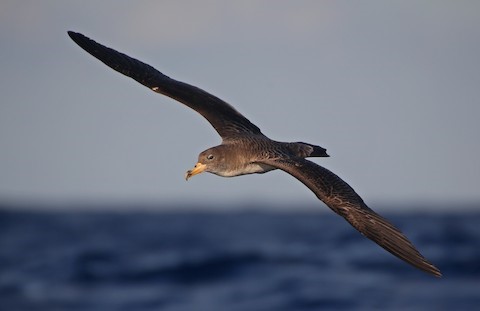
Cory’s Shearwater. (East of Madeira, Portugal; July 5, 2018.) © Paul Chapman
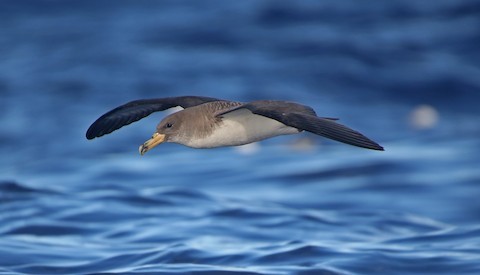
Cory’s Shearwater. (East of Madeira, Portugal; July 5, 2018.) © Paul Chapman
The upperparts are mostly brownish, typically appearing pale sandy or grayish and scaly on the body, and darker brown on the wings and tail. Often shows an irregular whitish band on the rump.

Cory’s Shearwater. (Offshore from Cape Hatteras, North Carolina; June 7, 2018.) © Brian Sullivan

Cory’s Shearwater. (Offshore from Cape Hatteras, North Carolina; May 22, 2017.) © Paul Budde
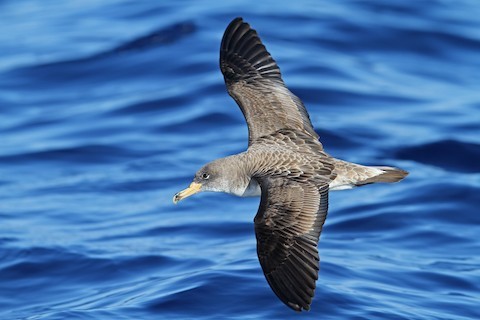
Cory’s Shearwater. (Offshore north of Madeira; August 4, 2011.) © Christoph Moning

Cory’s Shearwater. (Offshore north of Madeira; June 22, 2021.) © Peter Flood
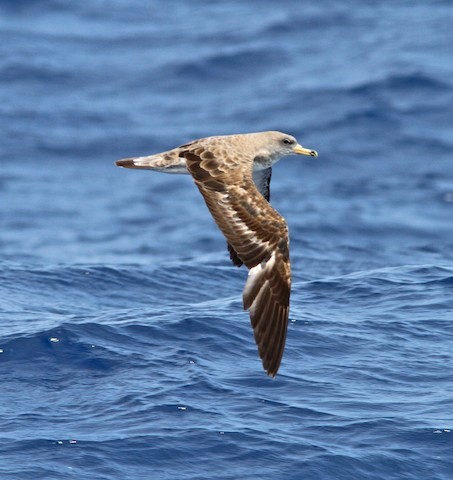
Cory’s Shearwater in heavily worn plumage, molting flight feathers. (Offshore from Cape Hatteras, North Carolina; August 13, 2011.) © Holly Merker

Cory’s Shearwater. (Offshore from Cape Hatteras, North Carolina; July 27, 2019.) © Dan Maxwell
The difference in their underwing patterns appears to be the only viable basis for separating Cory’s from Scopoli’s in the field without vocalizations, but it is tenuous and somewhat unreliable as some individual Cory’s show some white on the webs of the primaries (but less than on typical Scopoli’s), and lighting conditions often cause pale reflections on these feathers that are difficult—or impossible under field conditions—to distinguish from white coloration.

Cory’s Shearwater. (Offshore north of Madeira; June 28, 2021.) © Peter Flood
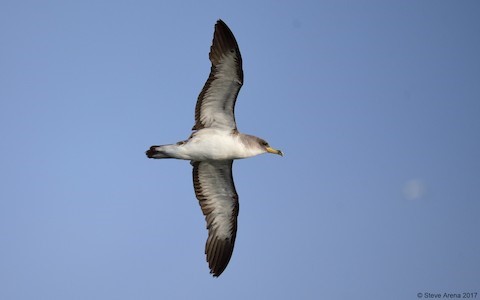
Cory’s Shearwater. (Race Point, Provincetown, Massachusetts; August 4, 2017.) © Steve Arena
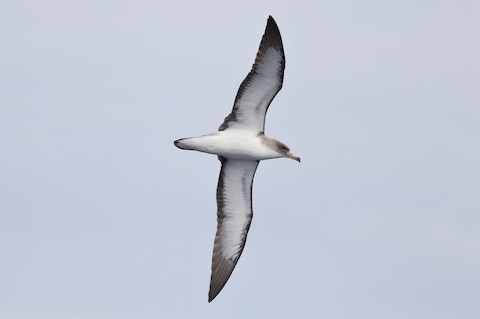
Cory’s Shearwater. (Offshore north of Madeira; June 27, 2021.) © Peter Flood

Cory’s Shearwater. (Banco de la Concepción, offshore northeast of Lanzarote, Canary Islands, Spain; April 10, 2016.) © Miguel Rouco

Cory’s Shearwater. (East of Madeira, Portugal; July 5, 2018.) © Paul Chapman
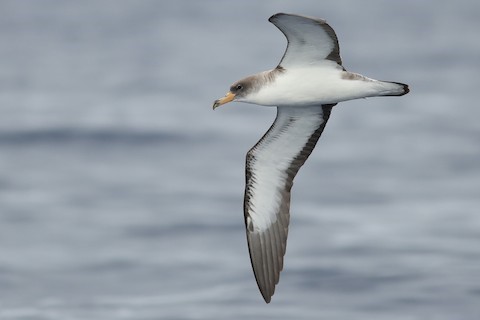
Cory’s Shearwater. (Offshore south of Madeira; June 29, 2021.) © Kate Sutherland

Cory’s Shearwater, showing small slivers of white at the base of the primaries. (Offshore north of Madeira; July 25, 2021.) © Mikael Käll
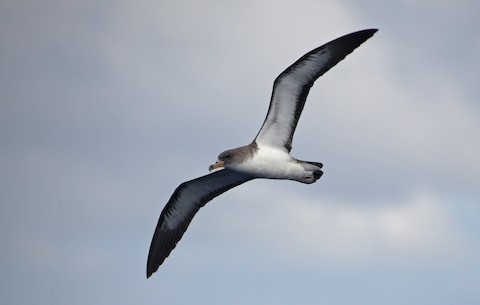
Cory’s Shearwater. (East of Madeira, Portugal; July 5, 2018.) © Paul Chapman

Cory’s Shearwater. (Offshore from Cape Hatteras, North Carolina; May 20, 2008.) © Brian Sullivan
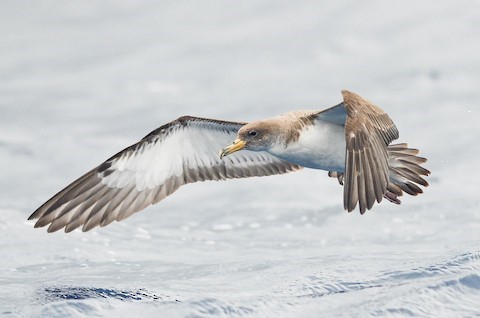
Cory’s Shearwater. (Offshore south of Pico, Azores; July 18, 2015.) © Annelies Jacobs
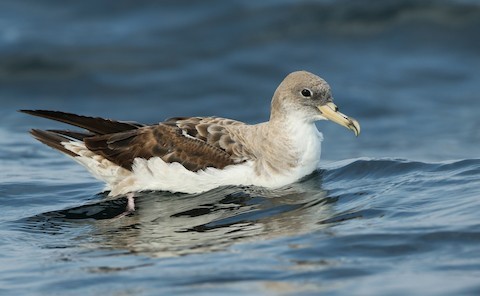
Cory’s Shearwater. (Offshore from Chatham, Massachusetts; August 21, 2017.) © Luke Seitz

Cory’s Shearwater, showing the dark undersides of its primaries. (East of Madeira, Portugal; July 3, 2018.) © Paul Chapman
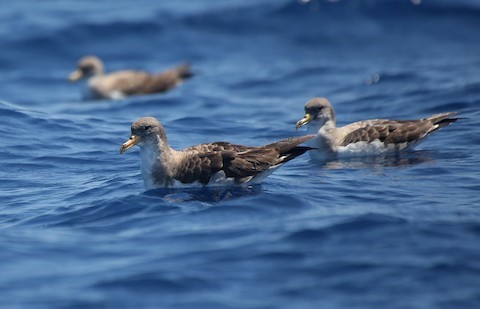
Cory’s Shearwaters. (East of Madeira, Portugal; July 3, 2018.) © Paul Chapman
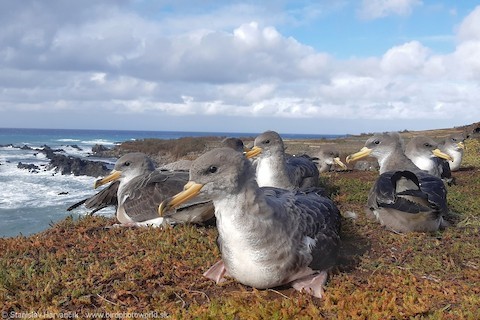
Cory’s Shearwater, juveniles in breeding colony. (Corvo, Azores; October 26, 2019.) © Stanislav Harvančík

Cory’s Shearwater, juvenile in breeding colony. (Corvo, Azores; October 12, 2018.) © Maciej Kowalski
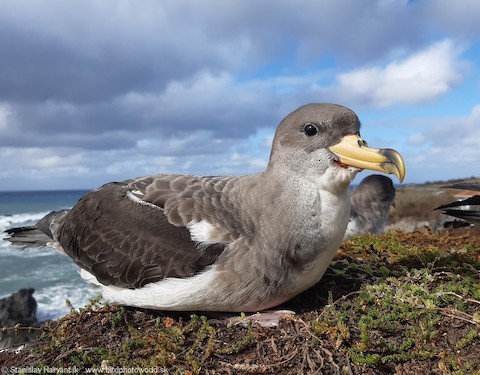
Cory’s Shearwater, juvenile in breeding colony. (Corvo, Azores; October 26, 2019.) © Stanislav Harvančík
Voice. Calls at colonies are guttural moans that alternate between quicker, higher-pitched inhalations and drawn-out, lower-pitched exhaled notes. The exhaled notes are more prominent and given in rapid bouts of three (unlike the slower couplets of Scopoli’s and other large shearwaters): (For a detailed review with more recordings and sonograms, see The Sound Approach: Cory’s Shearwater.)
Cf. Scopoli’s Shearwater. Cory’s and Scopoli’s Shearwaters occur together across most of the Atlantic Ocean and are so similar as to be visually indistinguishable under all but ideal viewing conditions. Nevertheless, the evidence that they are in fact separate species is compelling. Despite having broadly overlapping ranges, they rarely interbreed, and genetic evidence indicates that they diverged about one million years ago. The key differentiator is their vocalizations, which are crucial to mate selection in night-breeding seabirds, but are almost never heard away from their nesting areas or by day, and therefore rarely useful to most observers who try to identify them.
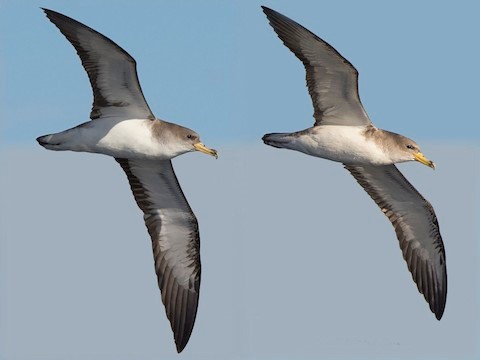
Cory’s (at left) and Scopoli’s Shearwaters. (Banco de la Concepción, offshore northeast of Lanzarote, Canary Islands, Spain; April 10, 2016.) © Miguel Rouco
Wingtips: The only visual difference that is usually diagnostic if seen clearly is the undersides of the outer primaries, which are all or mostly blackish on Cory’s, but show appreciable white on Scopoli’s. The typical Scopoli’s underwing has white on the inner webs of the primaries which extends about halfway from the primary coverts to the wingtips, most extensive on the outer few primaries. The white in Scopoli’s’ wingtips typically forms a wedge that extends outward from the white coverts and is often evident at long range, although false positives are possible because reflective lighting can create the same impression and some atypical Cory’s may have a similar extension of white in their primaries—though usually forming a smaller wedge than typical Scopoli’s. Meanwhile, Scopoli’s also varies internally and some individuals appear to have less white in their wingtips. Many individuals are ambiguous and not visually identifiable to species.
Structure: Cory’s averages about 5% longer in most measurements, and Scopoli’s varies geographically, so the two species overlap widely and size alone is rarely if ever diagnostic for field identification. However, there may be consistent structural differences related to size. Cory’s is generally more robust and has a larger skull than Scopoli’s. Although Cory’s has, on average, a thicker bill, the slimmer shape of Scopoli’s’ head can make its bill seem proportionately larger. Being lighter in weight, but similar in length, Scopoli’s may appear proportionately longer-winged and more buoyant in flight—note, however, that these differences would rarely if ever be diagnostic unless well-corroborated by other factors and assessed in side-by-side comparison.

Cory’s Shearwater. (East of Madeira, Portugal; July 5, 2018.) © Paul Chapman
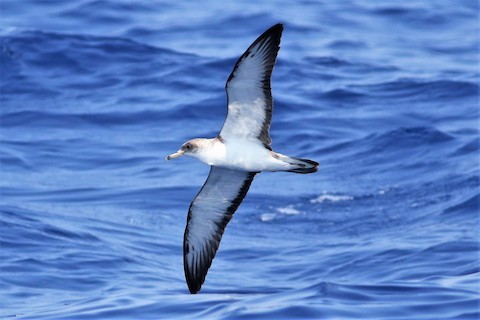
Scopoli’s Shearwater. (Offshore from Cape Hatteras, North Carolina; May 27, 2019.) © Peter Flood
Vocalizations: For a detailed discussion of the diagnostic vocal differences between Cory’s and Scopoli’s, with illustrative recordings, see The Sound Approach: Scopoli’s Shearwater. The article summarizes the differences as follows: “The most striking difference from Cory’s is that Scopoli’s tends to deliver its loud notes in twos, then ends with a breath note, whereas Cory’s usually delivers them in threes. In addition, the two notes of Scopoli’s are longer, and consequently their delivery sounds more laid back. A third difference is that there are prominent high-pitched, inhaled ‘hiccup’ sounds between the two loud notes of Scopoli’s.”
To put the differences in context, the author notes that the calls of all large shearwaters—both Calonectris and Ardenna—sound roughly similar to human ears, and the calls differ between the sexes. Amid this general similarity, only Cory’s typically gives three-note calls. Still, voice-based identification requires awareness of the natural variability inherent within each species, which can lead to confusion due to apparent overlap. Cory’s often starts with one- or two-note calls before progressing to its typical three-note calls. In both species, some calls can have extra notes added, so some Scopoli’s give atypical three-note calls. All of these details have been studied intensively with large sample sizes: “When over 400 males from both shearwaters were analysed, none showed two call characters of the other, such as number of notes plus note length, at the same time. For example, the minority of Scopoli’s with three-note calls still have longer notes and a slower delivery than Cory’s Shearwater, as well as more prominent ‘hiccups’ between the notes.”
Cory’s and Scopoli’s Shearwaters court at night in complete darkness, so it is logical to infer that the sounds they make are probably more important to mate selection than their visual appearances, which would make differences in their vocalizations instrumental to speciation. Evidence in support of this inference continues to accumulate, as small colonies of both Cory’s and Scopoli’s have been discovered within one another’s ranges—i.e., discoveries of Cory’s breeding at two sites in the Mediterranean, and of Scopoli’s breeding at two sites in the Atlantic—all confirmed by vocalizations. Thus when breeding in overlapping areas, Cory’s and Scopoli’s Shearwaters recognize differences between them sufficiently to form isolated outpost colonies instead of interbreeding, which objectively classifies them as separate species. Away from the colonies, however, they remain extremely challenging to identify by sight.
Cf. Cape Verde Shearwater. Cory’s, Scopoli’s, and Cape Verde Shearwaters overlap widely, as Cory’s and Scopoli’s circulate nearly throughout the temperate, subtropical, and tropical Atlantic, and the three are so similar as to be indistinguishable unless viewed closely under good conditions. They were traditionally considered to be a single species (known collectively as Cory’s Shearwater, C. diomedea), but Cape Verde is universally recognized as separate and there is compelling evidence that Cory’s and Scopoli’s, though very similar, are separate. Genetic analysis has shown that Scopoli’s and Cape Verde are more closely related to each other than either is to Cory’s.
Scopoli’s is intermediate in size between Cory’s and Cape Verde, and differs visually in having more white on its underwings. Typical Cory’s and Cape Verde have white underwing coverts and contrasting dark flight feathers. On Scopoli’s the undersides of the outer primaries have white on the inner webs, forming a wedge that extends out from the coverts toward the tip.
Size: In length measurements, Cape Verde averages about 10% smaller than Cory’s and 5% smaller than Scopoli’s. In side-by-side comparisons, the difference between Cory’s and Cape Verde is more pronounced than the length difference alone would indicate. Cory’s is much bulkier overall. Within each species, however, males are larger than females, so differences in their average sizes can be swamped by internal variation. To add confusion, Scopoli’s’ size varies across its range (eastern breeders are smaller than western breeders) and thus overlaps broadly with both Cory’s and Cape Verde.
Bill: Cape Verde can often be identified by its bill, which is thinner, grayer, and darker overall than the others. All show a blackish patch or ring near the tip, but on Cape Verde this tends to be larger and less distinct than on the others. Unlike Cory’s and Scopoli’s, Cape Verde’s bill pattern varies widely. At one end of the spectrum, some individuals have uniformly gray bills, while at the other end, some individuals have mostly pale bills with distinctly contrasting tips, as on Cory’s and Scopoli’s.

Cape Verde Shearwater, center, with three Cory’s or Scopoli’s Shearwaters, for a comparison of overall size, head and neck coloration, and bill color and contrast. (Offshore from Cape Hatteras, North Carolina; August 15, 2004.) © Tom Johnson

Cape Verde Shearwater, at left, beside a Cory’s or Scopoli’s Shearwater—note the apparent difference in head and bill sizes. (Offshore between São Nicolau and Ilhéu Raso, Cape Verde; April 26, 2013.) © Paul Chapman
Upperparts Plumage: Cape Verde differs in its typical upperparts plumage. It tends to appear somewhat darker and grayer overall than Cory’s and Scopoli’s, and more often shows a dark crown. Although plumage alone is rarely reliable for positive identification of Cape Verde, it can be useful in some circumstances as an initial indication or to corroborate other factors.
Notes
Monotypic species. Traditionally considered conspecific with Scopoli’s Shearwater (diomedea) and Cape Verde Shearwater (edwardsii), known collectively as Cory’s Shearwater (Calonectris diomedea).
References
Alderfer, J., and J.L. Dunn. 2014. National Geographic Complete Birds of North America (Second Edition). National Geographic Society, Washington, D.C.
BirdLife International. 2018. Calonectris borealis. The IUCN Red List of Threatened Species 2018: e.T22732244A132661794. https://dx.doi.org/10.2305/IUCN.UK.2018-2.RLTS.T22732244A132661794.en. (Accessed July 23, 2021.)
BirdLife International. 2018. Calonectris diomedea. The IUCN Red List of Threatened Species 2018: e.T45061132A132667885. https://dx.doi.org/10.2305/IUCN.UK.2018-2.RLTS.T45061132A132667885.en. (Accessed July 23, 2021.)
eBird. 2021. eBird: An online database of bird distribution and abundance. Cornell Lab of Ornithology, Ithaca, N.Y. http://www.ebird.org. (Accessed July 25, 2021.)
Flood, R.L., and R. Gutiérrez. 2019. Status of Cory’s Shearwater in the western Mediterranean. Dutch Birding 41:159-165.
Garcia-del-Rey, E. 2011. Field Guide to the Birds of Macaronesia: Azores, Madeira, Canary Islands, Cape Verde. Lynx Editions, Barcelona.
Garcia-del-Rey, E. 2018. Birds of the Canary Islands. Christopher Helm, London.
Harrison, P. 1983. Seabirds: An Identification Guide. Houghton Mifflin, Boston.
Howell, S.N.G. 2012. Petrels, Albatrosses & Storm-Petrels of North America. Princeton University Press.
Howell, S.N.G., and S. Webb. 1995. A Guide to the Birds of Mexico and Northern Central America. Oxford University Press.
Howell, S.N.G., and K. Zufelt. 2019. Oceanic Birds of the World. Princeton University Press.
Kirwan, G.M., A. Levesque, M. Oberle, and C.J. Sharpe. 2019. Birds of the West Indies. Lynx Edicions, Barcelona.
Mullarney, K., L. Svensson, D. Zetterström, and P.J. Grant. 1999. Birds of Europe. Princeton University Press.
Sinclair, I., P. Hockey, W. Tarboton, and P. Ryan. 2011. Birds of Southern Africa (Fourth Edition). Random House Struik (Pty) Ltd. Cape Town, South Africa.
The Sound Approach. 2019. Cory’s Shearwater, Calonectris borealis. https://soundapproach.co.uk/species/corys-shearwater/.
The Sound Approach. 2019. Scopoli’s Shearwater, Calonectris diomedea. https://soundapproach.co.uk/species/scopolis-shearwater/.
Wikiaves. 2021. Bobo-grande, https://www.wikiaves.com.br/wiki/bobo-grande. (Accessed July 25, 2021.)
Xeno-Canto. 2021. Cory’s Shearwater – Calonectris borealis. https://www.xeno-canto.org/species/Calonectris-borealis. (Accessed July 25, 2021.)
Xeno-Canto. 2021. Scopoli’s Shearwater – Calonectris diomedea. https://www.xeno-canto.org/species/Calonectris-diomedea. (Accessed July 23, 2021.)
